.

DELL
#4 MAY/JUNE 1951 ~ 36pp. 10cents

Front
cover, back covers, and interior art: Jesse Marsh
Writer:
Gaylord Du Bois
Cover: Jesse Marsh -
The scene on the cover has absolutely nothing to do with the story.
Inside Front Cover:
Ink drawings entitled “Tarzan Ape-English Dictionary” There are six "K"
words listed here: Kagoda (do you surrender or I do surrender); Kalo (cow);
Kando (ant); Kordo (dance); Kota (tortoise); and Kreeg-ah (beware).
The inside front cover presents
six of the twenty-one possible ‘K’ words in the Ape-English Dictionary.
(Note: there are no ‘I’ words in the Ape-English Dictionary. They skipped
the two possible “J” words.) They are a good limited choice.

“Tarzan and The
Lone Hunter”- 32 pp
Type -- Pal-ul-don -- Pan-at-lee
Rescue

ERBzine
2404: Dell No. 4
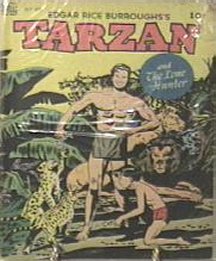 Jane
requests that Tarzan and Boy fill gourds with water for the tree house.
Boy wants a pipeline of water to the house. As they return with the gourds
a group of natives approach. They have been driven from their village by
the Bongus, a fierce tribe of witch people. Tarzan allows them to live
in the clearing by his house and near his protection. In exchange they
will help build a pipeline of water to the tree house. Boy, becoming bored
with the construction tasks, takes Tarzan’s rope and goes looking for adventure.
A man with cat-like ears comes. He is being stalked by numa. Boy ropes
the lion from a tree and calls for Tarzan. The stranger kills the lion
with one blow from his club. Tarzan recognizes Om-at, chief of the Waz-don,
his friend from Pal-ul-don. They take him to see Jane. Om-at explains that
he lost his wife Pan-at-lee’s trail in the Thorny Desert and that he came
here by accident.
Jane
requests that Tarzan and Boy fill gourds with water for the tree house.
Boy wants a pipeline of water to the house. As they return with the gourds
a group of natives approach. They have been driven from their village by
the Bongus, a fierce tribe of witch people. Tarzan allows them to live
in the clearing by his house and near his protection. In exchange they
will help build a pipeline of water to the tree house. Boy, becoming bored
with the construction tasks, takes Tarzan’s rope and goes looking for adventure.
A man with cat-like ears comes. He is being stalked by numa. Boy ropes
the lion from a tree and calls for Tarzan. The stranger kills the lion
with one blow from his club. Tarzan recognizes Om-at, chief of the Waz-don,
his friend from Pal-ul-don. They take him to see Jane. Om-at explains that
he lost his wife Pan-at-lee’s trail in the Thorny Desert and that he came
here by accident.
Om-at explains the whole story.
While Om-at and his men were out chasing Ho-don robbers, Tor-lot, son of
Es-at, was plotting his overthrow. Tor-lot and his gang slipped into Kor-ul-ja
at night and killed all who were loyal to Om-at. He then proclaimed himself
chief. Next, he made his way to Om-at’s cave. Pan-at-lee realized he was
coming. As Tor-lot climbed up the rock cliff to the cave, she pounded his
fingers with a stone club. Pan-at-lee escaped up the side of the cliff
as Tor-lot and his men came in pursuit. Pan-at-lee jumped into the Kor-ul-gryff,
gorge of gryffs. She had learned from Tarzan how to control gryffs. She
hit a gryff with her club and rode it to the Ro-don plains. Om-at returned
to learn of these events. Om-at left O-dan in charge and followed Pan-at-lee
into the Kor-ul-gryff. He trailed Tor-lot and his men to a swamp where
he killed three of them but one managed to escape. He followed Pan-at-lee’s
trail to the thorny desert which guards Pal-ul-don.
While they eat, Luga, one of
the natives living in Tarzan’s clearing, tells them he saw a woman with
cat-like ears living in a cave near his former village. Om-at follows Tarzan
through the trees for three days to Luga’s village. They go to the caves
that are inhabited by baboons. They learn from the baboons about the Bongus
raid and wonder if Pan-at-lee was captured by the witch people. They follow
her trail to a river where they recover Pan-at-lee’s belt. Deducing she
was captured while bathing, they travel to the Bongus village. They climb
a kopje to overlook the village. They see Bookrai, the Bongus witch doctor,
interrogating a woman accused of poisoning Dongool, the chief. The witch
doctor uses the ‘smoke of truth’ to get her to confess. She doesn’t. He
threatens to turn her into a black panther. Tarzan picks up Pan-at-lee’s
scent. They enter the village and find her drugged wearing a panther skin.
Two apprentice witch doctors come to get Pan-at-lee. Tarzan quickly subdues
them. Om-at takes her place in the panther skin as Tarzan carries Pan-at-lee
to safety.
Meanwhile Bookrai puts a powder
into the caldron, which creates a great deal of smoke. He sends two more
apprentices to bring Pan-at-lee. They carry the disguised Om-at to the
scene and replace him with the accused woman. As the smoke clears Bookrai
realizes the ruse. The Bongus approach the supposedly tied Om-at. He surprises
them with his attack. Tarzan joins the melee. He carries the wounded Om-at
over the Bongus’s wall to where he left Pan-at-lee. Om-at applies a healing
powder from Pal-ul-don to his wife’s wounds. The Bongus are coming so Tarzan
carries the groggy Pan-at-lee and adds Om-at to his arms as they flee.
They climb another kopje and hurl rocks down on the witch people. Tarzan
catches the scent of elephants in the area and calls them for help. The
elephants rout the Bongus. Tantor carries them back to Tarzan’s home. After
recovering, Om-at invites Tarzan to Pal-ul-don. Tarzan says if he does
come his need would be great. The next day Tarzan, mounted on Tantor, carries
Om-at and Pan-at-lee to the edge of Pal-ul-don. end
The title,
Tarzan and The Lone Hunter, comes almost as an after thought. The phrase
‘lone hunter’ is not used until the end of the story. Almost as if Du Bois
got to the last sentence and realized he needed a title for this work so
threw in the phrase. The story, although it has a sprinkling of Jane and
Boy at the beginning and the end, is more like Dell #1 in that it relies
heavily on a novel. This time the novel is Tarzan the Terrible.
The story revolves around Om-at who Tarzan befriended in Tarzan the
Terrible. Om-at, which means ‘long tail,’ has neither his prehensile
tail nor his opposable big toes. Instead, he has cat-like ears (a la Mr.
Spock nearly twenty years later in the Star Trek series) to denote him
as a foreign creature. His clothing is almost a simple Roman type tunic.
Om-at says he was chasing Ho-don robbers. The Ho-dons are depicted exactly
as the Waz-dons, black with cat-like ears not as white men with prehensile
tails.
In Tarzan
the Terrible Es-sat, the chief of the Waz-don, drives Om-at away and
makes advances towards Pan-at-lee. She escapes to the Kor-ul-gryf to be
rescued by Tarzan. Later she is captured by the Ho-dons. Om-at returns
to his home, kills Es-sat, becomes chief, and leaves Ab-on in charge. He
goes in search for Pan-at-lee, his sweetheart, with Tarzan, O-dan, and
Ta-den.
The Dell
story has some remarkable similarities. Es-at’s (slight spelling change)
son, Tor-lot usurps Om-at’s power. He makes an advance on Pan-at-lee, who
escapes to the Kor-ul-gryff (notice an extra ‘f’ is added to gryf). She
is captured by the Bongus, a tribe of witch people. Om-at leaves O-dan
as temporary gund, chief, while he searches for his wife, Pan-at-lee. On
the trail Om-at either kills or scares off Es-at, he is not sure which.
While
it is admirable that Du Bois down plays the Jane/Boy aspects of the story
to recapture some essence of Burroughs novels, he does use a number of
questionable changes and additions to the people of Pal-ul-don. When Om-at
meets Boy he uses a mixtures of ape and Pal-ul-don languages. Did Tarzan
teach Om-at the ape language? The physical changes are drastic. Was this
to make it more conventional for readers? Marsh has already proven that
he draws animals quite well so the decision couldn’t be based his artistic
skills. Why not show the Waz-dons with a tail, especially in the case of
Om-at whose name means long tail? Why depict the Ho-dons as black? Why
add an extra ‘f’ to gryf? Du Bois must have been knowledgeable of
the Pal-ul-don language to some extent. But then why add a new geographical
area and call it the Ro-don Plains, which translated means ‘flower man
plains?’ Doesn’t sound very Burroughsian. And finally when Tarzan talks
with the baboons he uses the Pal-ul-don word ‘o-dan’ in front of the mangani,
which translates as ‘like rock apes,’ (Tarzan used the term ‘people of
the rocks’ in Dell #3 to describe the baboons.) Do the baboons understand
the language of Pal-ul-don?
The new
twist
in the story, the inclusion of the Bongus witch people, is very nicely
handled. Bookrai, the chief witch doctor, with his so-called ‘smoke of
truth’ is a wonderful touch as Tarzan and Om-at expose his scam on the
people. The Bongus are easily outwitted by the pair and make their escape.
The use of the word ‘kopje’ is a questionable matter. The first use of
the word and pictures leaves the impression that a kopje is a rock. The
second use of the word comes closer to what the word means, a small hill.
The story seems to have finished before the required thirty-two pages because
the last two full pages are clearly filler items.
Marsh’s
drawings continue to use less and less of the shadow and silhouette type
of illustrations. There are no costume changes for Jane in this issue.
Her hair is no longer in a quaffed ponytail but is now tied with a ribbon
and allowed to fall down onto her shoulders more naturally. Is Marsh responsible
for the blandness of the Waz-don characters or are the editors? Marsh stays
with the six panels per page with slight variations until about two-thirds
the way through the story, then suddenly he uses a panel that takes up
two thirds of the page. It is quite dramatic and unexpected. A little later
during the battle scene with the Bongus he uses a four-paneled page equally
effectively. Both are visually exciting and heighten the effect of the
Bongus part of the story.
Even
with the flaws, the story is an interesting one and nice to see that the
writer has not given up on the novels as a source of inspiration.

Inside Back Cover: Ink
drawings entitled “Tarzan’s Ape- English Dictionary (continued).” There
are six "L" words listed: Litu (sharp); Lob (kick); Lu (fierce); Lul (water);
Lul-kor (swim); and Lus (tongue). The inside back cover presents six of
the possible twelve ‘L’ words.
Back Cover: Full figure
of Tarzan that extends from the top of the page to the bottom. He smiles
broadly as he carries a spear in his right hand and has a dead horta over
his left shoulder. This relates to one of the last scenes in the comic
when Tarzan and Boy return from the hunt only this time the spear and boar
are reversed in Tarzan’s arms. The vegetation is luscious in the background.
Jesse Marsh’s name appears near in the left bottom corner.
There are neither advertisements
nor extra non-Tarzan stories in this issue.

.


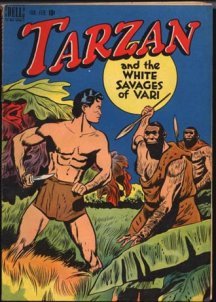
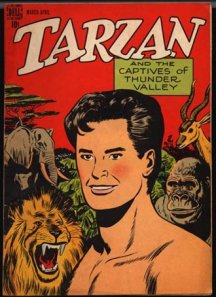
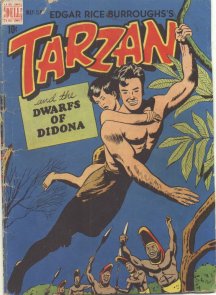

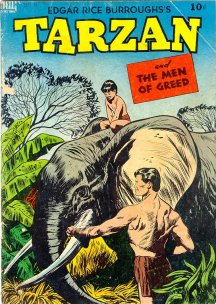
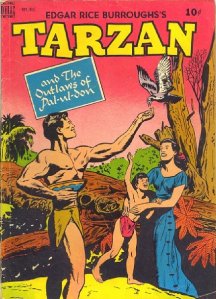
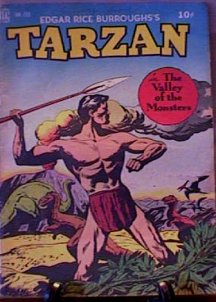
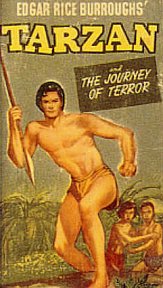 Better
Little Book: Whitman’s publication of Tarzan and The Journey of Terror,
1950, is based on
Dell #7 and #8. The cover is a new painting, artist
unknown. The back cover contains a Jesse Marsh head and shoulder shot of
Tarzan. The interior pictures are taken directly from the two comics. The
first half of the book is Dell #7 and the second half is Dell #8. The Better
Little Book is in a rectangular format 5” tall by 3” wide. Unlike the Big
Little Book format of alternating a script page with a picture page, the
Better Little Books have the picture and title covering the top two-thirds
of the page and the script covering the bottom third. The majority of Marsh’s
pictures for the two comics are in square panels. The BLB uses a rectangular
panel in keeping with the format of the book. To adjust for the differences
in the panels the solution most often is an addition of a small area at
the bottom of the original drawing. The majority of the time all that is
needed is the extension the foreground slightly. Sometimes it requires
some slight additional body extensions. Often times these body extensions
are not drawn with knowledge of human proportion or anatomy. In the second
half of the BLB, Dell #8, there are other slight variations such as: extending
the top sky area, trimming the edges off the originally drawing,
trimming edges and extending top or bottom, extending top as well as bottom,
or in a couple of cases, zooming in on a large original rectangular drawing
to capture the essence of that scene. Of course, the balloons from the
comics have been eliminated. In the second half of the BLB, on rare occasions,
the background of the panel has been changed; however, they are minor in
appearance. The panels are presented in black and white with an area of
pure green, which sometimes provides an emphasis point and other times
seems to be illogical. The story is rewritten for this format but is essentially
the same as Du Bois wrote it for the comics. There are a couple of minor
points left out, but the essence is there.
Better
Little Book: Whitman’s publication of Tarzan and The Journey of Terror,
1950, is based on
Dell #7 and #8. The cover is a new painting, artist
unknown. The back cover contains a Jesse Marsh head and shoulder shot of
Tarzan. The interior pictures are taken directly from the two comics. The
first half of the book is Dell #7 and the second half is Dell #8. The Better
Little Book is in a rectangular format 5” tall by 3” wide. Unlike the Big
Little Book format of alternating a script page with a picture page, the
Better Little Books have the picture and title covering the top two-thirds
of the page and the script covering the bottom third. The majority of Marsh’s
pictures for the two comics are in square panels. The BLB uses a rectangular
panel in keeping with the format of the book. To adjust for the differences
in the panels the solution most often is an addition of a small area at
the bottom of the original drawing. The majority of the time all that is
needed is the extension the foreground slightly. Sometimes it requires
some slight additional body extensions. Often times these body extensions
are not drawn with knowledge of human proportion or anatomy. In the second
half of the BLB, Dell #8, there are other slight variations such as: extending
the top sky area, trimming the edges off the originally drawing,
trimming edges and extending top or bottom, extending top as well as bottom,
or in a couple of cases, zooming in on a large original rectangular drawing
to capture the essence of that scene. Of course, the balloons from the
comics have been eliminated. In the second half of the BLB, on rare occasions,
the background of the panel has been changed; however, they are minor in
appearance. The panels are presented in black and white with an area of
pure green, which sometimes provides an emphasis point and other times
seems to be illogical. The story is rewritten for this format but is essentially
the same as Du Bois wrote it for the comics. There are a couple of minor
points left out, but the essence is there.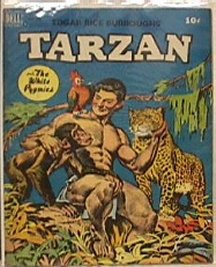
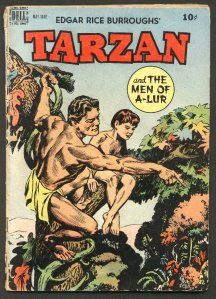
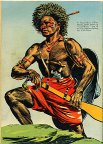 Inside
Back Cover: Pen and ink drawings entitled: Tarzan’s Ape-English Dictionary
(continued). All six "V" words are listed: Van (well); Vando (good); Vo
(muscle); Voo-dum (dance); Voo-voo (sing); and Vulp (full). The inside
back cover lists all six of the possible ‘V’ words. The illustrations are
nicely done, but one has a questionable vignette that probably would not
be acceptable in the ‘politically correct’ world of the twenty-first century.
Vando, good, is drawn as a native child about to take a bite out of a watermelon.
He has a big grin on his face. [There is nothing inherently wrong with
a child happily eating a melon. But some may take offense and read an underlying
racist intent.
Inside
Back Cover: Pen and ink drawings entitled: Tarzan’s Ape-English Dictionary
(continued). All six "V" words are listed: Van (well); Vando (good); Vo
(muscle); Voo-dum (dance); Voo-voo (sing); and Vulp (full). The inside
back cover lists all six of the possible ‘V’ words. The illustrations are
nicely done, but one has a questionable vignette that probably would not
be acceptable in the ‘politically correct’ world of the twenty-first century.
Vando, good, is drawn as a native child about to take a bite out of a watermelon.
He has a big grin on his face. [There is nothing inherently wrong with
a child happily eating a melon. But some may take offense and read an underlying
racist intent.
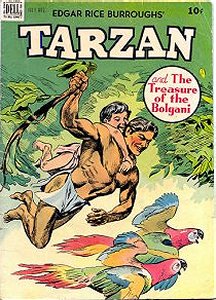
 Inside
Back Cover: Ink drawings entitled: “Tarzan’s Ape-English Dictionary. There
are six "W" words illustrated. Wa (green); Wala (nest, hut, home, house);
Wappi (antelope); Wang (arm); Wa-usha (leaf); and Whuff (smoke). The inside
back cover continues the Ape-English Dictionary. There are six of the eight
possible ‘W’ words illustrated.
Inside
Back Cover: Ink drawings entitled: “Tarzan’s Ape-English Dictionary. There
are six "W" words illustrated. Wa (green); Wala (nest, hut, home, house);
Wappi (antelope); Wang (arm); Wa-usha (leaf); and Whuff (smoke). The inside
back cover continues the Ape-English Dictionary. There are six of the eight
possible ‘W’ words illustrated.
